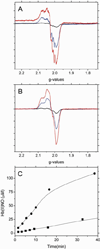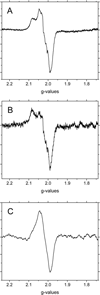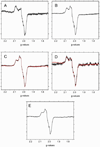A new paramagnetic intermediate formed during the reaction of nitrite with deoxyhemoglobin
- PMID: 21755997
- PMCID: PMC3166623
- DOI: 10.1021/ja1115088
A new paramagnetic intermediate formed during the reaction of nitrite with deoxyhemoglobin
Abstract
The reduction of nitrite by deoxygenated hemoglobin chains has been implicated in red cell-induced vasodilation, although the mechanism for this process has not been established. We have previously demonstrated that the reaction of nitrite with deoxyhemoglobin produces a hybrid intermediate with properties of Hb(II)NO(+) and Hb(III)NO that builds up during the reaction retaining potential NO bioactivity. To explain the unexpected stability of this intermediate, which prevents NO release from the Hb(III)NO component, we had implicated the transfer of an electron from the β-93 thiol to NO(+) producing ·SHb(II)NO. To determine if this species is formed and to characterize its properties, we have investigated the electron paramagnetic resonance (EPR) changes taking place during the nitrite reaction. The EPR effects of blocking the thiol group with N-ethyl-maleimide and using carboxypeptidase-A to stabilize the R-quaternary conformation have demonstrated that ·SHb(II)NO is formed and that it has the EPR spectrum expected for NO bound to the heme in the β-chain plus that of a thiyl radical. This new NO-related paramagnetic species is in equilibrium with the hybrid intermediate "Hb(II)NO(+) ↔ Hb(III)NO", thereby further inhibiting the release of NO from Hb(III)NO. The formation of an NO-related paramagnetic species other than the tightly bound NO in Hb(II)NO was also confirmed by a decrease in the EPR signal by -20 °C incubation, which shifts the equilibrium back to the "Hb(II)NO(+) ↔ Hb(III)NO" intermediate. This previously unrecognized NO hemoglobin species explains the stability of the intermediates and the buildup of a pool of potentially bioactive NO during nitrite reduction. It also provides a pathway for the formation of β-93 cysteine S-nitrosylated hemoglobin [SNOHb:S-nitrosohemoglobin], which has been shown to induce vasodilation, by a rapid radical-radical reaction of any free NO with the thiyl radical of this new paramagnetic intermediate.
Figures









Similar articles
-
S-nitrosohemoglobin: a mechanism for its formation in conjunction with nitrite reduction by deoxyhemoglobin.Nitric Oxide. 2006 Aug;15(1):20-9. doi: 10.1016/j.niox.2006.01.012. Epub 2006 Mar 20. Nitric Oxide. 2006. PMID: 16545588
-
Quantification of intermediates formed during the reduction of nitrite by deoxyhemoglobin.J Biol Chem. 2009 May 8;284(19):12710-8. doi: 10.1074/jbc.M808647200. Epub 2009 Mar 7. J Biol Chem. 2009. PMID: 19270306 Free PMC article.
-
Red blood cell membrane-facilitated release of nitrite-derived nitric oxide bioactivity.Biochemistry. 2015 Nov 10;54(44):6712-23. doi: 10.1021/acs.biochem.5b00643. Epub 2015 Oct 28. Biochemistry. 2015. PMID: 26478948
-
The new chemical biology of nitrite reactions with hemoglobin: R-state catalysis, oxidative denitrosylation, and nitrite reductase/anhydrase.Acc Chem Res. 2009 Jan 20;42(1):157-67. doi: 10.1021/ar800089j. Acc Chem Res. 2009. PMID: 18783254 Review.
-
Nitrite binding to myoglobin and hemoglobin: Reactivity and structural aspects.J Inorg Biochem. 2025 Apr;265:112829. doi: 10.1016/j.jinorgbio.2025.112829. Epub 2025 Jan 11. J Inorg Biochem. 2025. PMID: 39854981 Review.
Cited by
-
Letter by Stamler et al Regarding Article, "Nitrite and S-Nitrosohemoglobin Exchange Across the Human Cerebral and Femoral Circulation: Relationship to Basal and Exercise Blood Flow Responses to Hypoxia".Circulation. 2017 Jun 13;135(24):e1135-e1136. doi: 10.1161/CIRCULATIONAHA.117.027071. Circulation. 2017. PMID: 28606954 Free PMC article. No abstract available.
-
Optimized S-nitrosohemoglobin Synthesis in Red Blood Cells to Preserve Hypoxic Vasodilation Via βCys93.J Pharmacol Exp Ther. 2022 Jul;382(1):1-10. doi: 10.1124/jpet.122.001194. Epub 2022 May 5. J Pharmacol Exp Ther. 2022. PMID: 35512801 Free PMC article.
-
The enzymatic function of the honorary enzyme: S-nitrosylation of hemoglobin in physiology and medicine.Mol Aspects Med. 2022 Apr;84:101056. doi: 10.1016/j.mam.2021.101056. Epub 2021 Nov 28. Mol Aspects Med. 2022. PMID: 34852941 Free PMC article. Review.
-
Generating S-nitrosothiols from hemoglobin: mechanisms, conformational dependence, and physiological relevance.J Biol Chem. 2013 Aug 2;288(31):22408-25. doi: 10.1074/jbc.M113.482679. Epub 2013 Jun 17. J Biol Chem. 2013. PMID: 23775069 Free PMC article.
-
Nitric oxide formation versus scavenging: the red blood cell balancing act.J Physiol. 2012 Oct 15;590(20):4993-5000. doi: 10.1113/jphysiol.2012.234906. Epub 2012 Jun 11. J Physiol. 2012. PMID: 22687616 Free PMC article. Review.
References
-
- Palmer RM, Ferrige AG, Moncada S. Nature. 1987;327(6122):524–526. - PubMed
-
- Ignarro LJ. J. Physiol Pharmacol. 2002;53(4 Pt 1):503–514. - PubMed
-
- Palmer RM, Ashton DS, Moncada S. Nature. 1988;333(6174):664–666. - PubMed
-
- Denninger JW, Marletta MA. Biochim. Biophys. Acta. 1999;1411(2–3):334–350. - PubMed
Publication types
MeSH terms
Substances
Grants and funding
LinkOut - more resources
Full Text Sources

